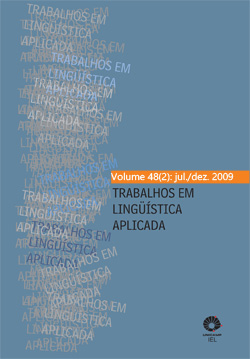Resumo
Este estudo trata de uma pesquisa de cunho etnográfico sobre a interação entre uma professora e seus pequenos aprendizes na aula de inglês como língua estrangeira (LE). Os dados da pesquisa foram coletados numa escola de Educação Infantil, por meio de gravações em vídeo, notas de campo da professora e de uma observadora. Conforme Ellis (1997), aqueles que cuidam de crianças, que estão aprendendo a língua materna, tendem a modificar seu discurso ao falarem com elas. Assim também acontece com professores que atuam com alunos com idade abaixo de seis anos. Os resultados desse estudo podem contribuir para tornar professores, atuantes no ensino de inglês-LE para crianças, mais conscientes do papel que o seu discurso tem como facilitador da compreensão nas interações na sala de aula de LE.
ABSTRACT:
This study reports on an ethnographic investigation about the interaction between a teacher and her very young learners (VYL) in the English as a foreign language (FL) classroom. In order to carry out this investigation, data were collected in a private kindergarten school, by means of video recordings of classes and field notes from the teacher and from an observer. As Ellis (1997) states as caretakers tend to modify the way they speak to children when these ones are learning the mother language, so teachers do modify their speech when communicating with learners. The results of this study may contribute to make teachers of VYL aware of the role of teachers’ discourse as a facilitator of understanding in interactions in the FL classroom.
Key-words: interaction; teacher/student; English-FL.
Referências
BROWN, H.D. (1994). Teaching by principles – An interactive approach to language pedagogy. USA: Prentice Hall.
BUTT, D., FAHEY, R., FEEZ, S., SPINKS, S.; YALLOP, C. (2001). Using Functional Grammar: An Explorer’s Guide. 2nd Edition. Sydney: Macquarie University.
CAMERON, L. (2001). Teaching English to Young Learners. Cambridge: Cambridge University Press.
CANT, A.; SUPERFINE, W. (1997) Developing resources for Primary. London: Richmond.
CELCE-MURCIA, M. (1991). Teaching English as a Second or Foreign Language. 2nd edition. Heinle & Heinle.
CHARRINGTON, M.; COVILL, C. (2003). Peekaboo. Oxford: Macmillan.
CHRISTIE, F. (2002). Classroom Discourse Analysis – A Functional Perspective. New York: Continuum.
CONSOLO, D.A. (1996). Classroom Discourse in Language Teaching: A Study of Oral Interaction in EFL Lessons in Brazil. Tese de doutorado. The University of Reading, England.
_______. (2000). Teachers’ Action and Student Oral Participation in Classroom Interaction. In J.K.
HALL & L.S. VERPLAETSE (Eds). Second and Foreign Language Learning Through Classroom Interaction. p. 91-108. London: Lawrence Erlbaum Associates Publishers.
COOK, V. (2001). Second Language Learning and Language Teaching. London: Arnold.
DELANEY, J. (2000). Very Young Learners (4 - 8): What can we do with them? Disponível em: http:/ /www.richmondpark.net/events/chat14.html Acesso em 30 July 2004.
ELLIS, R. (1997). Second Language Acquisition. Oxford: OUP.
FREITAS, M.A. (2001). Theoretical and practical views of interaction. In M.B.M. FORTKAMP; R.P.
XAVIER (Eds.). EFL Teaching and Learning in Brazil: Theory and Practice. Editora Insular: UFSC. p.193-201.
KRASHEN, S. (1981). Second Language Acquisition and Second Language Learning. Oxford: Pergamon.
HALL, J.K.; VERPLAETSE, L.S. (2000). Second and Foreign Language Learning Through Classroom Interaction. Lawrence Erlbaum Associates, Publishers: London.
HALL, J.K.; WALSH, M. (2002). Teacher-student interaction and language learning. Annual Review of Applied Linguistics, 22. p.186-203.
HEBERLE, V.M. (2001). Observing EFL Classrooms in Primary or Secondary Schools: A Research Task in Applied Linguistics. Revista Ilha do Desterro, 41, Florianópolis. p. 093-117.
HERRERA, M.; PINKLEY, D. (2005). Backpack. New York: Pearson Longman.
PAINTER, C. (1989). Learning the Mother Tongue. Oxford: OUP.
_______. (1999). Learning Through Language in Early Childhood. London, New York: Continuum.
PIRES S.S. (2004). Ensino de inglês na Educação Infantil. In SARMENTO, S.; MÜLLER, V. (Orgs) O ensino do inglês como língua estrangeira: estudos e reflexões. Porto Alegre: APIRS. p.19-42.
ROTH, G. (1998). Teaching Very Young Children – Pre-school and Early Primary. London: Richmond Publishing.
SNOW, C.E.; BARNES, W.S.; CHANDLER, J.; GOODMAN, I.F. (1991). Unfulfilled expectations: home and school influences on literacy. Harvard: London.
YULE, G. (1996). The Study of Language. 2 nd edition. Cambridge: Cambridge University Press.
O periódico Trabalhos em Linguística Aplicada utiliza a licença do Creative Commons (CC), preservando assim, a integridade dos artigos em ambiente de acesso aberto, em que:
- A publicação se reserva o direito de efetuar, nos originais, alterações de ordem normativa, ortográfica e gramatical, com vistas a manter o padrão culto da língua, respeitando, porém, o estilo dos autores;
- Os originais não serão devolvidos aos autores;
- Os autores mantêm os direitos totais sobre seus trabalhos publicados na Trabalhos de Linguística Aplicada, ficando sua reimpressão total ou parcial, depósito ou republicação sujeita à indicação de primeira publicação na revista, por meio da licença CC-BY;
- Deve ser consignada a fonte de publicação original;
- As opiniões emitidas pelos autores dos artigos são de sua exclusiva responsabilidade.

